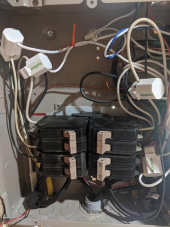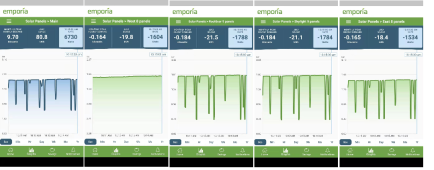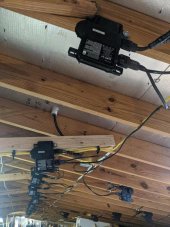I just had a 6.5 H debacle with Enphase doing every possible way to waste me and the clients time, before final a tech support girl went immediately to the problem, bad firmware in a whole year of production 2019 into 2020.
Then it had to be elevated to a higher level, where only they could push the new firmware.
The entire process took from January 17th 2024 to Feb 3, 2024, and they are still trying to update 2 microinverters.
Beyond frustrating, it is outright damaging. Even the female support "Evona" said she was surprised no one else had caught this "well known software glitch)
-------------------------------------------------------------
- Another online complaint
I created 4 arrays , labeled as follows: (They are all mounted on the same roof plane 180° azimuth)
West Panels (8 IQ7AS micros)
Roofdoor Panels (9 SPWR-A4 micros)
Skylight Panels (9 SPWR-A4 micros)
East Panels (8 SPWR-A4 micros)
I noticed that the "per panel" production was less on the panels with the SPWR-A4 micros (built in 2019 and 2020) than the West Array which had the 8 IQ7AS micros built in 2018
I decided to install an inexpensive Emporia monitoring system on the sub-panel of my 4 arrays. The Emporia can monitor and plot the data in 1 second intervals. While I could not monitor each panel (like Enphase Enlighten), at least I could see the aggregate output of each array.
This is what I saw: The leftmost graph is the total output of all 4 arrays, followed by the 4 readings from the individualized arrays:


You notice that only the West Panel array had a smooth output, while the other 3 arrays (and the Total output ) showed power drop-outs "glitches". All the graphs are synchronized and represent a 5 minute time-frame.
Since I installed all of my micros in my floored attic, I was able to swap the micros very easily. All of the wiring takes place on the roof rafters where the micros are attached (see picture below)

When I swapped the West array micros with the East array micros, the problem followed the micros. This eliminated my panels and wiring from the equation.
I then contacted Enphase and the agent looked at my system and could find no problems and said everything was operating correctly. I then did some more testing
- I put a DC clamp-on current meter on the outputs of each panel while watching the second-by-second Emporia plot on my phone. I could see the DC current would be about 8.39 Amps , drop to ZERO and then recover a few seconds later to 8.39 Amps. This happened in sync with the Emporia plot. The output did not glitch on the array with the IQ7AS micros made in 2018.
- Only 3 of the 26 SPWR-A4 micros did not have the power dropouts. No drop-outs on the
- I observed that the glitches did not occur in the early morning until later in the morning when the panel output were about 70 Watts.
- It was not temperature related because the glitches would disappear when intermittent cloud cover reduced the outputs of the panels below 70 watts during any time of the day
- I downloaded different "grid profiles" to all micros, but that did not eliminate the problem
- I measure the dc voltages from the panels and all were well within the specifications on the datasheet.
- I monitored the panels from 11:00 to 4:00 PM (when no panels are shaded) and I found that the panels with the glitching micros were losing 10% of their production. This corresponded with the duty-cycle of the glitches
I talked to the "LEVEL 2" representative and was told they could find nothing wrong or no pending firmware upgrades. They said that they could not trust the plots I shared with them from EMPORIA, a 3rd party device. I was frustrated and given the contact information of the Enphase Field Representative for my location.
- I sent multiple emails to the Enphase Field Representative.......NO RESPONSE
- I researched the patent data-base and then contacted that engineer at Enphase.......NO RESPONSE
- I found the CEO's email and other top ENPHASE staff and sent them my data............NO RESPONSE
- I called SunPower (because Enphase tried to "pass the buck") and they confirmed that they have nothing to do with the microinverter design and firmware
- I added more data of this problem to the ENPHASE Community Blog
FINALLY on July 12th, (a month after I discovered the problem) an Enphase Engineer/moderator in Australia saw my blog and fixed the problem!!!!! Before I got up in the morning, he had facilitated updating the firmware in my micros. I watched the Emporia plots as the outputs of the panels approached the 70 Watt "glitching threshold"........NO MORE POWER DROP OUTS!!
What troubles me is that these were micros which were originally installed on panels (somewhere) and they had to be unknowingly misbehaving on that installation. Enphase probably shipped millions of these with the firmware that had this problem. I would have thought that Enphase would have immediately known how to resolve this when I first called them in JUNE.
I encourage others to install an Emporia monitoring system!


No comments:
Post a Comment